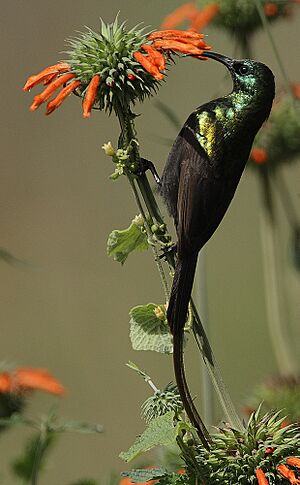Bronzy sunbird facts for kids
Quick facts for kids Bronzy sunbird |
|
|---|---|
 |
|
| Male feeding on Leonotis blossoms | |
| Conservation status | |
| Scientific classification | |
| Genus: |
Nectarinia
|
| Species: |
kilimensis
|
The bronzy sunbird (Nectarinia kilimensis) is a small, colorful bird found in parts of Africa. These birds are known for their long, curved beaks, which help them drink nectar from flowers. They belong to the Nectariniidae family, which includes all the sunbirds.
Contents
What Do Bronzy Sunbirds Look Like?
Bronzy sunbirds have a special look! Males often appear black, but in the right light, you can see hints of bronze and green. They have a long, thin, and curved beak, perfect for sipping nectar.
Male vs. Female
Female bronzy sunbirds look a bit different. They have a pale stripe above their eye, like an eyebrow. Their belly is yellowish with fine streaks. Unlike the males, females do not have any purple colors in their feathers.
Their Unique Calls
Bronzy sunbirds make interesting sounds! They often start with a mix of quick, twittering notes. This is usually followed by clear, whistling sounds. You can hear these calls most often in the early morning and around midday.
Where Do Bronzy Sunbirds Live?
You can find bronzy sunbirds in many parts of Africa. They are not super common, but they prefer certain places. They often live near the edges of Afromontane forests and on mountain sides. You might also spot them in Zimbabwe's eastern highlands and nearby Mozambique.
Countries They Call Home
Besides Zimbabwe and Mozambique, these birds live in several other countries. These include Angola, Burundi, the Democratic Republic of the Congo, Ethiopia, Kenya, Malawi, Rwanda, Tanzania, Uganda, and Zambia.
Their Favorite Places
Bronzy sunbirds like to stay away from busy towns and cities. They have adapted to live in remote areas. Their homes can be savannas, dry shrub-lands, grassy areas, or even rural gardens. They are most common in subtropical forests and bushy areas.
How Do Bronzy Sunbirds Behave?
Bronzy sunbirds have interesting habits, especially when it comes to food and family.
What Do Bronzy Sunbirds Eat?
The diet of the bronzy sunbird is quite specific. They mainly eat nectar from flowers. But they also enjoy a meal of spiders and various insects.
- Insects they eat:
How Do Bronzy Sunbirds Raise Their Young?
When it comes to raising babies, the female bronzy sunbird does most of the work. After the eggs are laid, the male often leaves.
- Egg Laying: Females lay 1 to 2 eggs, usually between September and May. The busiest time for laying eggs is from October to December.
- Nest Building: The female builds the nest all by herself. It takes her about 5 to 15 days to finish it. The nest is shaped like an oval basket.
- Nest Materials: She uses bits of ferns, dry grass, bark, leaves, and even spider webs to hold it all together. The entrance to the nest is covered by a small flap. Inside, it's lined with fine grass and soft plants.
- Caring for Chicks: Once the eggs hatch, the female feeds and protects the chicks. They stay in the nest for about 16 to 21 days. After that, they still return to the nest for about another week. They become fully independent around 2 to 3 weeks later.
Are Bronzy Sunbirds in Danger?
Good news! The bronzy sunbird is not considered a threatened species. Their numbers are stable.
A Surprising Benefit
Interestingly, these birds have actually benefited from something called Protea farming. Protea is a type of flower that is grown in gardens, especially in Zimbabwe. While this flower is poisonous to humans, it doesn't harm the bronzy sunbird. In fact, Protea flowers provide a huge amount of nectar, making them a favorite spot for sunbirds to visit and feed.


